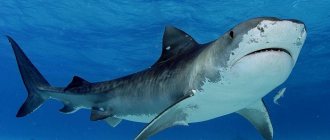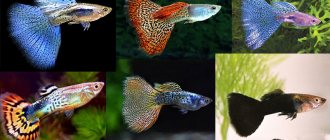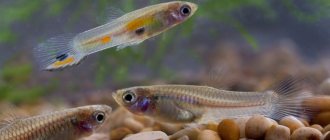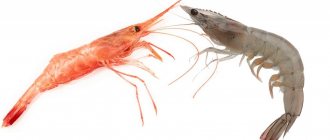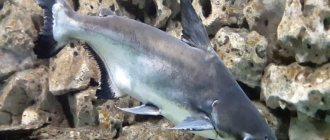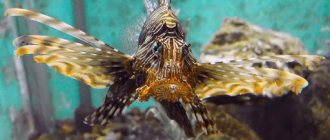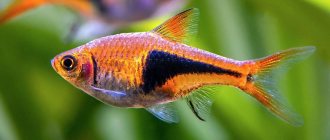We all know that sharks are dangerous. But are they really that scary? In fact, this giant fish rarely attacks humans. In many ways, our interest in sharks is fueled by the media with countless reports and news, as well as films in which a group of people suddenly find themselves on the high seas, surrounded by sharks. Of course, in the movies no one survives or only one person remains alive; in life the situation could have turned out completely differently...
Are you afraid of sharks? After you look at these miniature fish, your fear will probably be replaced by some other emotion - for example, tenderness. So, let's find out which sharks are considered the smallest in the world - we present you with their names and photos.
Horned - up to 150 cm
The horned shark is a very strange fish, you just have to look at it to understand it. The shark lives in shallow depths along the entire coastline of Australia, with the exception of the northern part. Lives approximately 30 years. The size of the fish is small - it rarely exceeds 150 cm in length and 10 kg. in weight.
The multifunctional mouth of a horned shark is surprising and at the same time frightening: dozens of sharp front teeth are designed for catching fish, the back of the jaw, where the large teeth are located, crumble the shells of mollusks, crabs, etc.
The shark does not choose how to satisfy its hunger - it consumes everything it comes across. The shape of horn shark eggs is impressive! Having seen the masonry, you may not understand what it is.
Wobbegong - carpet shark
Part fish, part blanket, she looks like a cross between a Persian rug and a catfish. This master of camouflage blends perfectly into the seabed with intricate skin patterns and a terry beard.
The Wobbegong uses its ability to hide to launch surprise attacks on small fish. Lying motionless on the seabed, the shark focuses its gaze on a point directly in front of its head and waits for its prey to appear at that location.
Carpet sharks can grow to almost 3m in length and are actually quite dangerous. There have been over 50 reported attacks in Australia, and while none of them have been fatal, they can certainly leave a very nasty sting.
Cat - up to 100 cm
A shark with an interesting name and no less interesting appearance settles in shallow water, where it feeds on crustaceans and fry. The shark got its name for a reason - it has light-sensitive sensors (which are located near its charming and unusual eyes), with the help of which it senses electrical signals emanating from another living creature.
The color of the shark is gray-charcoal, with dark spots along the body. Her body is quite slender and really flexible, like a cat's. On average, the shark is 75 cm long and weighs 1.5 kg. Of course, compared to large sharks, the catfish is very small, so some even keep it in aquariums.
Content Features
When you mention sharks, terrible images appear in your head: a toothy grin, an unfortunate tourist caught in the mouth of a predator.
It's hard to imagine that a shark is an aquarium fish that can swim peacefully in a home aquarium. You can start it at home without fear - it is small in size compared to sea predators, and is not prone to any aggression.
Aquarium sharks are small copies of their predatory cousins, but are not actually their direct relatives. Fish do not have a pronounced hunting instinct, they are not bloodthirsty. Under natural conditions, these fish live in freshwater rivers of Thailand and Vietnam and are the object of fishing.
In this video you will learn more about this fish:
In order for your fish to feel comfortable in a home aquarium, you need to comply with some conditions:
- The water temperature should be constant, its range is +22...+29°C.
- The pH of the water is maintained at 6.5−8.0.
- Each individual should have at least 40 liters of water.
- 30% of the water in the aquarium should be changed weekly.
- It is necessary to ensure good filtration and aeration, and create a strong current.
- Grottoes and caves should be built in the aquarium so that the living conditions of the fish are as close as possible to natural ones.
Feeding shark fish is not difficult; they can eat a wide variety of foods. The main condition is the presence of a large amount of proteins and carbohydrates in food. Pets are fed 2-3 times a day, and the diet includes both animal and plant components.
- shrimp meat;
- frozen fish;
- small insects;
- grated cucumbers;
- cabbage;
- zucchini;
- various types of cereals;
- small live fish.
Vympelnaya - up to 60 cm
The pennant shark (also known as “ shark catfish ” or “ pangasius ”) is most similar in appearance to the predator. In the natural environment it reaches 1.5 m, and at home it does not exceed 60 cm in length. This black fish is very shy, it is agile and grows quickly.
If the pangasius begins to rush from side to side in panic, then this is a clear sign that something has frightened it. The pennant shark is very voracious - it happily consumes special food, fish and squid.
Aquarists who are going to keep a pennant shark in their aquarium must remember one thing - they cannot put fry with it, because it will regard them as food.
Buying tips
Small sharks for an aquarium will feel comfortable only if the owner knows the rules for purchasing the fish themselves and a home for them. It is recommended to house one type of fish in one container, since different species differ in character, size and lifestyle. This creates stress for the fish and reduces their lifespan. Instances of the same species, but of different sizes, will also feel uncomfortable. These features of fish must be taken into account when purchasing.
Don't forget to prepare a favorable environment for the shark
When choosing an aquarium, focus on the following parameters:
- Volume. There should be at least 40 liters per shark, but this does not mean that you can buy a 40-liter aquarium and put one fish there. The more water in the container, the better your pet will feel.
- Size. The fish must not only fit in the aquarium in length and width, it must be provided with the ability to turn around freely and swim at high speed.
- Form. For inhabitants with a bottom lifestyle, you can buy a square or rectangular aquarium. If the fish lives in the middle water column, choose round containers. A round house is good because the absence of corners prevents pets from getting injured during turns at high speed.
- Filtration and aeration system. The water in a shark aquarium must be perfectly purified and enriched with oxygen; for this purpose, powerful filter units are purchased. The ideal option is external filters that provide multi-stage water purification.
With good care, a domestic shark lives 8-12 years, some individuals can live 20-25 years. During this time, the fish becomes a real member of the family and everyone’s favorite, delighting owners and guests with its unusual appearance.
Black - up to 50 cm
The black shark is a beautiful fish, and it can even be called graceful. She loves to eat, so if you don’t feed her on time, she can attack her neighbor in the tank. Outwardly, the black shark may look like its predatory counterparts, but it has nothing to do with predators.
Two-color varieties of shark - with a red tail, are distinguished by their aggressive character. There are also albinos - their body is almost completely transparent. In an artificial environment, a shark grows up to 50 cm, but only in favorable conditions. When living conditions worsen, this is reflected in the appearance of the shark - it becomes lighter. Thus, she talks about her problems, which must be solved by the one who keeps her in the aquarium.
Types of sharks for the aquarium
Most of the fish that are united under the word “sharks” have nothing to do with the predators of the oceans and seas. Most of the species come from Thailand, where they are successfully bred on farms and in rivers.
Black Shark
This species is only superficially similar to its predatory counterparts, but it has nothing to do with predators. In an artificial environment they grow up to 40-50 cm. The body color is deep black, but there are also two-color varieties with a black body and a red tail. Among black sharks, they are the most aggressive and complex in character. There are also albinos with an almost transparent body. The black shark may lose color intensity if it is not fed well. Underfeeding the fish means endangering other smaller inhabitants.
Dwarf shark
One of the most popular species among aquarists is the dwarf shark. It has a small body size of up to 25 cm and an interesting feature - it glows. This species is endowed with a luminescent organ - a photophore. The pectoral and pelvic fins and the abdomen itself begin to luminesce in a state of excitement. This is a viviparous fish that can bear up to 10 sharks, 5-6 cm in size.
Asian catsharks
Heat-loving bottom fish are capable of reaching a meter in length, but on average grow to 60-70 cm. They prefer to be nocturnal and hide in shelters during the day. The average length of individuals is 1 meter. Fish are placed in aquariums with a volume of at least 1.5 thousand liters.
The species combines three varieties that are most often kept by aquarists:
- brown striped;
- Indian coral;
- epaulette.
The brown-striped is especially popular . When young, its body is white-gray with black transverse stripes, but as it matures, the color changes and becomes completely brown or reddish. For aquarium keeping, individuals whose size does not exceed 25-40 cm are bred.
The coral shark has a very varied coloring of brown and yellow spots on a light background, for which it is called spotted. The average body length is 30-40 cm. Its small size and sedentary lifestyle make it possible to keep a coral shark in a tank with a volume of 1 thousand liters or more.
Cat sharks are quite capricious: they love warm, clean water containing iodine. The species is capable of reproduction in an aquarium.
Horn sharks
From the heterotooth family, aquariums contain representatives of the genus horned or, as they are also called, bull sharks. Their distinctive feature is a large head and growths above the eyes, and a spine is located in front of each dorsal fin. They grab prey with their front very small and sharp teeth, then crush it with their large back teeth. The length of individuals can reach 1.15 m.
Whitetip reef shark
The fish got its name from the white borders of the caudal and dorsal fins. The general color is dark gray with noticeable spotting on the sides. The fish is nocturnal, preferring to spend the day in shelters. In an aquarium, it can lie on the bottom for a long time without moving. The size of a whitetip shark can reach up to 1.5 m. But an artificially grown species reaches an average of 40-50 cm.
It is kept in panoramic or large cylindrical aquariums with a water volume of 1.5 to 3 cubic meters. It feeds on fish, squid, and crustaceans. Whitetip sharks are not kept with larger fish.
Peace-loving species that can fight back are suitable for her:
- moray eel;
- rock bass;
- snapper;
- Wobbegong.
Blacktip or Malagasy reef shark
The black tips of the fins are the reason why this species is called blacktip sharks. The black tip of the anterior dorsal fin stands out especially. The body has a double color: the belly is white, the back is yellow-brown or yellow-gray. These fish are very active. They need a lot of free space in the aquarium and a large volume (at least 3000 liters). Decorations should not have sharp, protruding corners. The blacktip shark can act very nervously and make sudden movements. Aquariums in the shape of a sphere or a cylinder are suitable for its maintenance, in which the fish can swim without experiencing difficulties when turning around.
Bearded wobbegong
A fairly rare representative of sharks that can be found in aquariums is the bearded wobbegong. His head is very wide and completely covered with a fringe of leather. Hence the name, which translated means “shaggy beard.” The belly is painted white, the rest of the body has a motley, mosaic color, which allows it to be well camouflaged in natural conditions.
This is one of the slowest swimmers in its family. He leads a solitary lifestyle, spending a lot of time in shelters. Even living in an aquarium, he prefers to be in a cave. The wobbegong is not active in searching for prey - it attacks from ambush.
Carpet Wobbegongs get along well in captivity. In artificial conditions they can grow up to 1.6-1.8 meters. They feed on everything they can swallow.
Pennant shark
The external resemblance to a shark makes pangasius from the shark catfish family very popular among aquarists. It is also called the “freshwater”, “pennant”, “iridescent” shark. In the natural environment, pangasius reaches 1.5 meters, in an aquarium it does not grow more than 50-60 cm. The average length they reach is 30-35 cm. This is a fast-growing, shy and active fish. In 3-4 months in warm and frequently changed water, they grow to their maximum size and can even outgrow the aquarium.
Shark catfish are very voracious. Eats specialized food, squid, fish, beef heart. The presence of protein in the diet and control over the amount eaten is very important, since pangasius is prone to overeating. For the same reason, small fish are not kept with him, which he can regard as food. The recommended number of feedings is 1-2 per day.
If something scares the fish, it begins to rush around in a panic attack at the front and side walls of the tank. Therefore, a cover glass is required. Pangasius can pretend to be dead and remain in this state for up to 20 minutes, and then come back to life.
Look at the sharks in the aquarium:
Shark catfish feels good in an aquarium equipped with driftwood, boulders, and a device that provides unidirectional water flow. Silver sharks need clean water. A large accumulation of organic matter has a bad effect on their well-being.
It is recommended to populate in a group of 5 or more individuals. With a smaller number, a hierarchy is built very quickly and the weakest fish can be bullied.
Pennant pangasius does not breed in aquariums.
Spiny - up to 50 cm
This beautiful spiny shark (aka “ Katran ”) inhabits the waters of California, Australia, South Africa, etc. It lives at a depth of 100-200 m, but sometimes rises closer to the surface. Its dimensions are quite small - it does not exceed 1.5 cm in length, and there are smaller specimens - 40-50 cm.
The shark does not attack people, but if someone grabs its tail, it will not “keep silent”, but will bite its offender. All spiny sharks (there are 26 species in total) have 2 dorsal fins, in front of which there are sharp spines - they pose a great danger to a diver because they are covered with poisonous mucus. In the event of an “injection,” the victim may experience severe swelling.
Ethmopterus perry
Photo: Javontaevious/Wikimedia Commons
This shark can easily be considered the smallest in the world. The length of her body is only 212 mm. Moreover, such figures were recorded in only one of all specimens ever caught and measured. The average dimensions are in the range of 170-180 mm.
These baby sharks were first described by ichthyologists S. Springer and D. Burgess in 1964. Based on many characteristics, researchers classified them as belonging to the genus of black spiny sharks, which includes 36 species. It is noteworthy that all representatives of the genus are small in size, and among them there are almost no individuals with a body length of more than 500 mm.
In terms of body structure, Ethmopterus perri sharks are not very different from their relatives. They have a flat head, making up about a quarter of the fish's entire length. In the mouth there are about 30 pairs of very sharp teeth, the bases of which are closed. The large eyes are slightly elongated. There are 2 dorsal fins on the body, as well as 2 pectoral, 2 pelvic and 1 caudal fins. The anal fin is absent. Almost the entire surface of the body is covered with thin teeth.
The smallest shark is usually dark brown in color. On the back you can see a darker stripe running along the entire body. On the belly, a quite distinct pattern emerges from several stripes, and part of this pattern can be illuminated thanks to photophores.
The distribution of the species Ethmopterus perry is limited to a small area in the southern Caribbean Sea. It has been established that the comfortable depth for these sharks is in the range of 280-440 m. It is also known about these fish that they reproduce their offspring in an ovoviviparous manner, bearing 2 or 3 babies at once. Other small sharks
This is interesting: Fauna of the Novosibirsk region - list, characteristics and photos
Black two-color - up to 50 cm
The black bicolor shark can perhaps be called the most beautiful inhabitant of the home tank. She has a black-velvet body and a bright tail, which stands out effectively against the background of her body.
Aquarists, wanting to see this fish in their aquarium, are ready to forgive its character - the black shark is very aggressive and has a complex disposition. For this reason, it is undesirable to add other fish to it - most likely, conflict will not be avoided. With proper care, the black shark grows up to 50 cm in length.
Breeding
It is almost impossible to distinguish young individuals by gender. The shark reaches sexual maturity at the age of four years, while the freshwater female is lighter in color and much more massive than the male. Breeding aquarium fish at home is problematic and almost impossible. In Asia, shark catfish farming is done in lakes or water containers.
In the natural environment, adult fish go to spawn from July to November, moving upstream, spawning in underwater thickets, laying up to 100 thousand eggs. The fry appear after 2–4 days, after which Pangasianodon hypophthalmus return to their usual environment.
Dwarf cat - up to 19 cm
Cat sharks (also known as " ribbon cat sharks ") have several subspecies. These babies inhabit the Indian Ocean and the South China Sea. They are especially numerous off the coast of India and the Philippines. Prefers to stay near the bottom.
Externally, the shark has a slender and narrow body, it has a small and rounded head and characteristic large eyes. One of the smallest sharks, when grown, does not exceed 19 cm, but we are talking about females, males are even smaller - they have a body length of up to 16 cm. The food for the dwarf shark is even smaller bottom inhabitants - fry.
Other small sharks
Several more species can lay claim to the title of the smallest representatives of the shark world:
- Panamanian black cat shark - body length 230 mm.
- Indian ribbon shark - 240 mm.
- African black shark - 240 mm.
- Green spiny shark - 260 mm.
- Horned black shark - 270 mm.
- Dwarf shark (from the family Dalathiaceae) - 270 mm.
- Dwarf spiny shark - 280 mm.
- Cuban cat shark or Florida cat shark - 320 mm.
Didn't find what you were looking for? Use the site search form
Did you like the article? Leave a comment and share with your friends
Dwarf lantern - up to 18 cm
The oceans and seas of our planet are inhabited by various interesting creatures - some of them are formidable predators, others are overly touching, and others are very ridiculous, like the Luna fish. the dwarf lantern shark belong to ? We leave this up to your discretion.
This baby is so small that it fits in your hand - the shark grows up to 18 cm in length. It lives in tropical and temperate waters of the Atlantic, Pacific and Indian oceans at depths of up to 10,000 meters.
Like all lantern sharks, it has luminous areas on its belly and fins - the fish uses them for camouflage at shallow depths, and at greater depths for hunting.
Habitat
The habitat of the dwarf shark is very extensive. It covers tropical and temperate waters. Within the Southeast Atlantic this fish lives:
- near Ascension Island;
- in a westerly direction from the Cape of Good Hope;
- in the South Africa area;
- in the waters east of the island of Fernando de Noronha.
The distribution in the Indian Ocean covers the open waters of Madagascar and Western Australia.
In the North Pacific Ocean, the pygmy shark inhabits the following areas:
- USA;
- Hawaiian Islands;
- Midway Island.
In the southern part of the same ocean, the distribution area occupies the space between New Zealand, southern Chile and Phoenix Island.
Dwarf spiny - up to 16 cm
The dwarf spiny shark is found in all oceans of the planet except the Arctic. Males do not exceed 15 cm in length, and females can grow a little more - up to 20 cm.
The dwarf shark has an elongated, spindle-shaped body, a pointed nose and a long muzzle. Has bright big eyes. This baby feeds on various bottom fish, which, of course, are even smaller than itself. According to observations, the spiny shark descends to a depth of 200-500 m to catch prey.
Goblin shark (brownie)
These sharks are sometimes called "living fossils." This is another prehistoric creature “roaming” our deep seas. They are the only surviving members of their family, the Mitsekurina, which dates back 125 million years ago.
These sharks live in the twilight zone at depths of more than 200 m, where they slowly “hover” in search of prey. Goblin sharks have been spotted in the depths of the Mariana Trench. They have a very long snout, similar to a nose, and round, well-fed bodies. Their entire appearance resembles goblins.
This is interesting: What poisonous species of spiders are there in Russia - list, characteristics and photos
Blackfin - up to 15 cm
It is not surprising that visitors to aquariums spend most of their time watching sharks - these frightening and beautiful predators instantly attract attention.
You can enjoy sharks (albeit small ones) at home if you set up an aquarium for them. Some people enjoy keeping miniature sharks. The blackfin shark (also known as the “ Malagasy night ”) shark is always in motion - to breathe it requires constant circulation of water through the gills, because the fish does not have gill covers.
Distributed in the Indo-Pacific. Shark skin is like sandpaper, so contact with it can cause extensive, deep damage to the skin. The blackfin shark lives for about 30 years, growing up to 15 cm in length.
7 3
Structural features and appearance
The dwarf shark has a miniature dark brown (almost black) elongated body of a conical shape, tapering towards the tail. The head of this fish is very large, and the muzzle is blunt and compressed, moderately long.
The eyes of the pygmy shark are large, round and can glow green in the dark. Behind them are sprinklers. The gill slits are very small and evenly wide. The snout accounts for 2/5 of the length of the head.
The pygmy shark's mouth is rounded, framed by thin fleshy lips, on which there is no fringe. The teeth on the upper and lower jaws are very different. Their structure corresponds to the characteristics of all deep-sea sharks of the Dalathiaceae family. The latter are characterized by the following tooth structure:
- the upper ones are smaller, with narrow, sharp, straight points, and have a curved awl-like shape;
- the lower ones are large, with a high, wide, almost vertical tip, the cutting edge is triangular in shape, the bases close together, forming a solid blade.
The pygmy shark has all smooth teeth. On the upper jaw they are arranged in 29 rows, and on the lower jaw - in 34.
The body of Euprotomicrus bispinatus resembles a tadpole in appearance. The dorsal fins are very small, with the second one being much larger than the first. They are located closer to the tail part of the body.
On the back of this fish there is no “triangle” typical of sharks. The pectoral fins have a rounded shape, and the anal fins are completely absent. The caudal fin of Euprotomicrus bispinatus differs from the heterocircular crescent-shaped structure common to sharks. In the pygmy it is asymmetrical, but not lobed. The upper and lower parts are rounded and almost identical (close to the homocercal type). The subterminal notch on the fin is well developed. Precadal pits and subterminal carinae on the caudal peduncle are absent.
The entire lower part of the shark's body is covered with bioluminescent organs - photophores. Their size is very small (0.3-0.8 mm), but together they give a very powerful glow. Photophores do not burn constantly, but only when the shark is in an excited state.
Shark catfish diseases
The first causes of shark disease are due to poor care, improper feeding and non-compliance with water standards or the size of the aquarium. Before you begin treating fish, it is necessary to correctly diagnose the disease and identify the causes of its occurrence.
The most common diseases:
- Pangasius in an aquarium can often damage itself by hitting the walls or being damaged by decorative objects. Subsequently, ulcers may appear on the skin of the decorative shark; the wound must be treated with potassium permanganate or brilliant green.
- In case of poisoning, treatment will be fasting or a protein diet.
- Oxygen starvation. Pangasius aquarium is located at the surface of the water, the catfish often swallows air. Urgently increase aeration, reduce temperatures, increase flow rate using a filter.
- Fin rot. Fin rot is most often caused by bacteria or a bite from another fish.
- Dropsy or bloating. Improve nutrition and water quality.
- Ichthyophthiriasis or white spots - bad water.
- Fungal disease or fish mold is white growths that look like mold. Dirty water.
Almost all fish diseases are related to water quality, so be careful. If you notice any changes, take action immediately.
Adviсe
Follow the standards for care and maintenance and you will be able to avoid many problems, and your Pangasianodon hypophthalmus will always be irresistible and attract your attention.
- The shark aquarium must be equipped with everything necessary.
- Don't hand feed.
- Wear gloves when cleaning.
- When adding a new individual to the aquarium, keep it separately for a while to make sure it is healthy.
- It is advisable to keep sick fish separately during the treatment period until complete recovery.
- Purchase a test kit to measure water quality.
- Clean the filter more often.
Remember that the responsibility for the life of this graceful fish, which directly depends on you.
A shark aquarium is an amazing underwater world that has strong magnetism. You can watch its inhabitant for hours; this is a kind of therapy that relieves stress and eliminates the fatigue accumulated during a hard day at work.
Previous Fish4 stages of reproduction of female and male bettas
